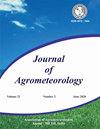Heat wave characterization and its impact on carbon and water vapour fluxes over sugarcane-based agroecosystem
Q3 Agricultural and Biological Sciences
引用次数: 0
Abstract
Global climate change expected to exacerbate the temperature extremes and intensity of heat waves in recent decades. The terrestrial biosphere plays a crucial role in absorbing carbon from the atmosphere. Therefore, understanding how terrestrial ecosystems respond to extreme temperatures is essential for predicting land-surface feedbacks in a changing climate. In light of this, a study was conducted to assess the effects of 2022 heat wave [March-May (MAM)] on carbon and water vapour fluxes. This study utilized the measurements obtained from the eddy covariance tower mounted within the sugarcane agroecosystem. The study period (MAM) was characterized into three events: Heat wave event 1 (HE1), Heat wave event 2 (HE2), Non heat wave event (NHE). The variation in carbon and water vapour fluxes, along with meteorological variables, during these events in 2020 and 2022 was further analysed. Our findings indicate that the heat wave caused a decrease in net ecosystem exchange (NEE), leading to an increase in atmospheric CO2 concentration during HE1, HE2 compared to NHE. In HE1, maximum NEE in 2020 and 2022 was -19.15 µmol m-2 s-1 and -13.21 µmol m-2 s-1, respectively. Furthermore, the heat wave events led to a decrease in latent heat flux (LE) and sensible heat flux (H), with changes of up to 5% in LE and 57% in H compared to the same period in 2020. These results highlight the significant impact of the heatwave on both carbon and energy fluxes. Overall, the present study provides a valuable reference for further climate change analysis, specifically focusing on both carbon and energy fluxes within sugarcane ecosystem.甘蔗农业生态系统的热浪特征及其对碳和水蒸气通量的影响
全球气候变化预计将加剧近几十年来的极端温度和热浪强度。陆地生物圈在吸收大气中的碳方面发挥着至关重要的作用。因此,了解陆地生态系统对极端温度的反应对于预测气候变化中的地表反馈至关重要。有鉴于此,进行了一项研究,以评估2022年热浪【三月至五月(MAM)】对碳和水蒸气通量的影响。本研究利用了安装在甘蔗农业生态系统内的涡流协方差塔的测量结果。研究期间(MAM)分为三个事件:热浪事件1(HE1)、热浪事件2(HE2)和非热浪事件(NHE)。进一步分析了2020年和2022年这些事件期间碳和水蒸气通量的变化以及气象变量。我们的研究结果表明,与NHE相比,热浪导致净生态系统交换(NEE)减少,导致HE1、HE2期间大气CO2浓度增加。在HE1中,2020年和2022年的最大NEE分别为-19.15µmol m-2 s-1和-13.21µmol m-1。此外,热浪事件导致潜热通量(LE)和显热通量(H)下降,与2020年同期相比,LE和H的变化分别高达5%和57%。这些结果突出了热浪对碳通量和能量通量的重大影响。总的来说,本研究为进一步的气候变化分析提供了宝贵的参考,特别是关注甘蔗生态系统内的碳和能量通量。
本文章由计算机程序翻译,如有差异,请以英文原文为准。
求助全文
约1分钟内获得全文
求助全文
来源期刊

Journal of Agrometeorology
农林科学-农艺学
CiteScore
1.40
自引率
0.00%
发文量
95
审稿时长
>12 weeks
期刊介绍:
The Journal of Agrometeorology (ISSN 0972-1665) , is a quarterly publication of Association of Agrometeorologists appearing in March, June, September and December. Since its beginning in 1999 till 2016, it was a half yearly publication appearing in June and December. In addition to regular issues, Association also brings out the special issues of the journal covering selected papers presented in seminar symposia organized by the Association.
 求助内容:
求助内容: 应助结果提醒方式:
应助结果提醒方式:


